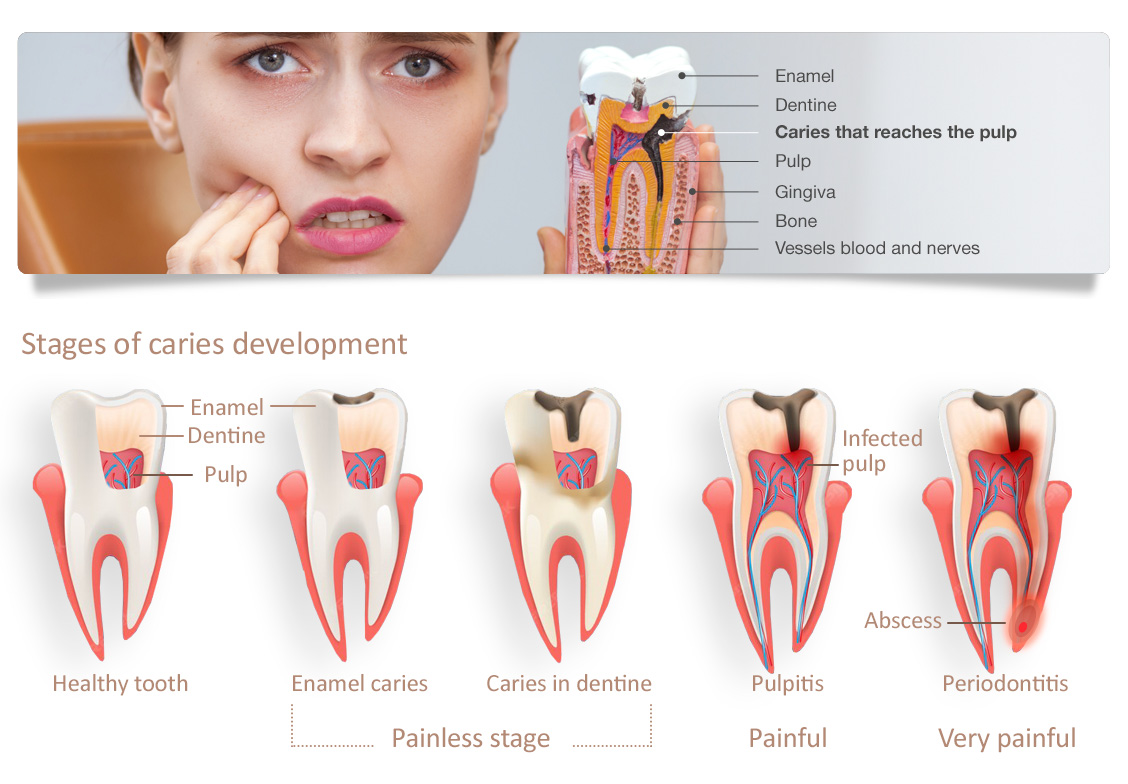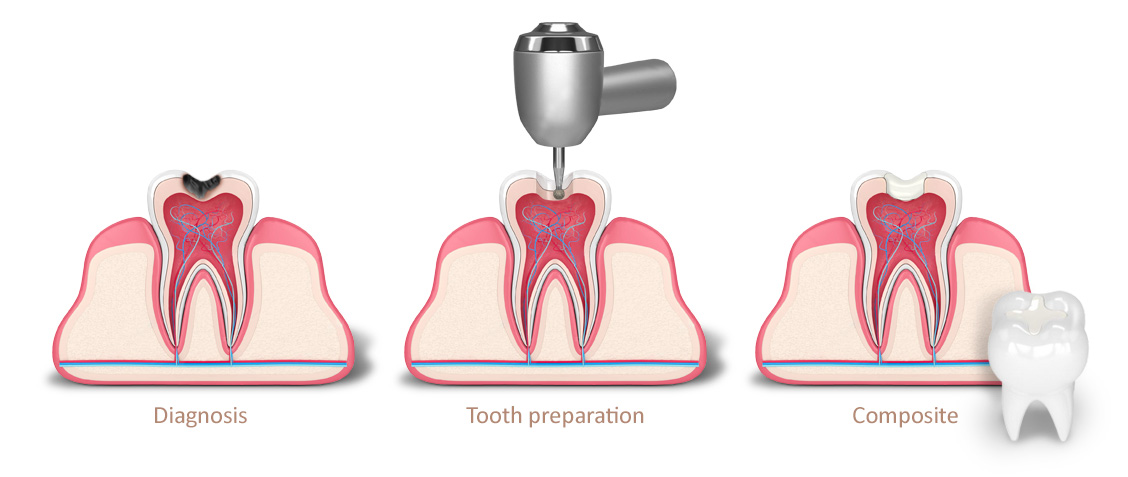
Dental filling is a common treatment used to repair damage caused by cavities. Its primary goal is to remove decayed tissue and restore the functionality and aesthetics of the affected tooth. Oral health is essential for overall well-being.
What is a dental filling?
A dental filling, also known as a restoration, is an essential procedure in dentistry to restore teeth affected by cavities. This treatment helps preserve oral health and prevent more severe complications in the future. The goal is to restore both the functionality and aesthetics of the tooth.
This process is fundamental in preventing cavities from progressing and reducing the risk of more serious infections that could require more invasive treatments, such as a root canal.
Importance of oral health
Oral health plays a crucial role in a person’s overall well-being. Maintaining a healthy mouth not only prevents dental problems but is also linked to systemic health. Key aspects to consider include:
- • Prevention of infections that may affect other parts of the body.
- • Contribution to good nutrition by facilitating chewing and digestion.
- • A positive impact on self-esteem and quality of life, as a healthy smile influences personal perception.
- • Reduction of the need for more extensive and costly treatments in the future.
Therefore, getting dental fillings in a timely and proper manner is an essential part of preventive dental care.
Causes of dental cavities
Dental cavities are a very common oral health problem, and their development is influenced by several factors. Understanding their causes is essential for effective prevention.

Factors that contribute to cavity formation
Cavities form due to the interaction of multiple factors, including:
- • Oral bacteria: Plaque builds up on the teeth and produces acids when fermenting sugars from food.
- • Sugar consumption: Diets high in sugars and carbohydrates promote bacterial growth and acid production.
- • Poor oral hygiene: Lack of brushing and improper flossing allow plaque to accumulate.
- • Insufficient fluoride: A lack of fluoride in water and hygiene products increases the risk of cavities.
- • Genetic factors: Genetic predisposition can affect tooth resistance to cavities.
How to prevent dental cavities
Preventing cavities is possible through healthy habits and daily care. Some methods include:
- • Maintaining good oral hygiene: Brushing teeth at least twice a day and flossing daily.
- • Balanced diet: Limiting sugar and acidic beverage intake and choosing nutrient-rich foods.
- • Regular dental visits: Periodic check-ups to detect problems early and receive dental cleanings.
- • Using fluoride products: Using fluoride toothpaste and mouthwashes to strengthen tooth enamel.
How is a dental filling performed?
The dental filling procedure, usually completed in a single visit, is carried out in several stages to ensure proper repair of the tooth affected by cavities. Each phase is essential to achieve an optimal and long-lasting result.
- 1. Diagnosis: Through an examination and, if necessary, X-rays, we detect the presence of cavities or other conditions requiring treatment.
- 2. Tooth preparation: The decay is removed with specific instruments, and the affected area is cleaned to prevent infections.
- 3. Filling material placement: The filling material is applied, which may be composite (tooth-colored resin) or ceramic, depending on each case.
- 4. Shaping and adjustment: The filling is molded to fit perfectly with the patient’s natural bite.
- 5. Curing and polishing: If composite is used, it is hardened with a special light and then polished for an aesthetic and functional finish.
Types of dental fillings
Choosing the right type of dental filling is crucial for ensuring proper repair and functionality of the affected tooth. Various materials are available, each with its own characteristics, advantages, and disadvantages.
Composite or resin fillings
Composite fillings, also known as composite resin, are one of the most commonly used materials today. This type of filling is mixed to match the natural tooth color, making them ideal for visible teeth.
Silver amalgam
Silver amalgam was a commonly used filling material for years due to its durability. However, its use was banned in Spain and the European Union in 2025 due to its high mercury content, a metal harmful to health and the environment. Today, safer and more aesthetic materials like composite resin and ceramic are preferred.
Post-filling care
After receiving a dental filling, it is essential to follow certain care guidelines to ensure proper healing and longevity of the treatment. Paying attention to these details helps prevent complications and maintain optimal dental health.
Recommendations to avoid complications
To prevent discomfort or issues after a filling, consider the following recommendations:
- • Avoid very hot or cold foods immediately after the procedure, as sensitivity in the treated area is common.
- • Limit the consumption of hard or sticky foods, which could affect the integrity of the filling.
- • Consult your dentist if you experience prolonged pain or sensitivity, as this may indicate an issue requiring attention.
How to maintain filling durability
Diet and healthy habits
A balanced diet significantly contributes to dental health. It is recommended to:
- • Moderate sugar intake: Reduce the consumption of sweets and sugary drinks.
- • Increase the intake of fruits and vegetables, which are beneficial and help keep teeth clean.
- • Drink enough water, preferably fluoridated, to strengthen tooth enamel.
Proper oral hygiene
To keep the filling in optimal condition, it is essential to follow good dental hygiene practices:
- • Brush teeth at least twice a day with fluoride toothpaste, paying special attention to the filling area.
- • Use dental floss daily to remove food debris between teeth and prevent plaque buildup.
- • Visit the dentist regularly for check-ups and professional cleanings to ensure continued oral health.
Impact on dental aesthetics
Fillings can affect dental aesthetics depending on the material used. Composite fillings offer a more natural appearance and blend with the tooth’s color. In contrast, amalgam fillings are more visible and are therefore typically used in less exposed areas.
The perception that fillings always negatively impact a smile is a myth. With advancements in dental technology, it is possible to perform treatments that not only repair but also enhance the appearance of teeth.
Frequently asked questions about dental fillings
There are several common concerns among patients regarding dental fillings. Below are some frequently asked questions that may arise during and after treatment.
Duration and sensations after treatment
The lifespan of a dental filling varies depending on the material used and the patient’s oral care habits. Generally, composite fillings last between 5 and 10 years. Proper oral hygiene and regular dental visits are key to maximizing their durability.
When to contact the dentist after a filling
It is important to be alert to any unusual symptoms after receiving a dental filling. Some signs that indicate a visit to the dentist is necessary include:
- • Persistent sensitivity or sharp pain in the filled tooth.
- • Swelling in the gums or areas near the filling.
- • Discomfort when biting or performing chewing functions.
- • Visible infections, such as pus around the tooth.
Early attention to these signs can prevent major complications and ensure proper treatment. Maintaining good communication with the dentist is essential for preserving oral health.
Take care of your smile with Clínica Áureo
If you notice sensitivity, discomfort, or think you might need a filling, at Clínica Áureo, we are here to help. Our team of specialists will assess your case and offer the best solution to keep your oral health in optimal condition.








